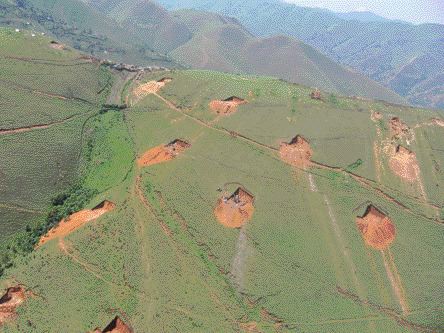Vancouver — A northern extension of the Twangiza deposit is returning strong gold grades for Banro Resources (BAA-T, BAA-X) as the company moves the project through a prefeasibility study in the Democratic Republic of the Congo (DRC).
While working on Twangiza earlier this year, Banro discovered the new gold zone north of the main deposit. The results from 38 cores drilled at Twangiza North confirmed the discovery.
In the main section of Twangiza North, which is roughly 800 metres long, hole 123 intersected 13 metres grading 6.71 grams gold per tonne (from 68 metres depth), and nearby holes 118 and 124 hit 17.3 metres of 3.54 grams gold (from 105 metres) and 41 metres of 3.39 grams gold (from 73 metres), respectively.
Other holes tested a northern extension of Twangiza North, a second zone roughly 900 metres long, offset from the main section by 500 metres. In this northernmost extension, hole 127 returned 4.58 grams gold over 23 metres from 11 metres down-hole and hole 115 returned 20.5 metres grading 2.31 grams gold from 28 metres depth.
Twangiza North hosts an inferred resource of 7.8 million tonnes grading 3.52 grams gold, an estimate that does not include data from the recent drill program. Together, the deposits at Twangiza host measured resources of 14.5 million tonnes grading 2.82 grams gold, indicated resources of 31.6 million tonnes of 1.81 grams gold, and inferred resources of 47.5 million tonnes grading 2.02 grams gold.
Banro discovered Twangiza North by drilling out a gold-in-soil anomaly. Unlike the mineralization at Twangiza Main, where gold is hosted predominantly in shales and siltstones, at Twangiza North, mineralization is associated with feldspar porphyry sills with intruded sediments. The deposit remains open to the north and at depth.
The Twangiza property consists of six exploitation permits totalling 1,164 sq. km in the South Kivu province of the DRC, 45 km southeast of the provincial capital, Bukavu. Banro owns the project outright through a DRC subsidiary, Twangiza Mining.
Banro’s preliminary assessment of Twangiza considered an open-pit mine with average annual production of 317,500 oz. gold in the first seven years of operation, falling to 260,300 oz. per year for the remainder of a 13-year mine life. The assessment pegged operating cash costs at US$215 per oz. and gave the project a post-tax net present value of US$511 million based on a 5% discount rate and a gold price of US$600 per oz. Total initial capital costs are projected at US$347.5 million.
The mine schedule proposes sequential mining: 21.2 million tonnes of oxide ore would be mined first, followed by 12.4 million tonnes of transitional ore and then 33 million tonnes of fresh rock ore.
Metallurgical studies indicate that the transitional and fresh rock porphyry, as well as the oxide ores, are non-refractory, while the transitional and fresh rock sediments are refractory. The study proposed a conventional gravity-carbon-in-leach (CIL) processing facility with an annual throughput of 5 million tonnes.
Banro also contracted Knight Pisold of Vancouver to study a number of potential hydroelectric sites nearby.
The company hopes to have a full feasibility study completed in the second half of 2008.


Be the first to comment on "Banro’s Twangiza North Extension Shapes Up"